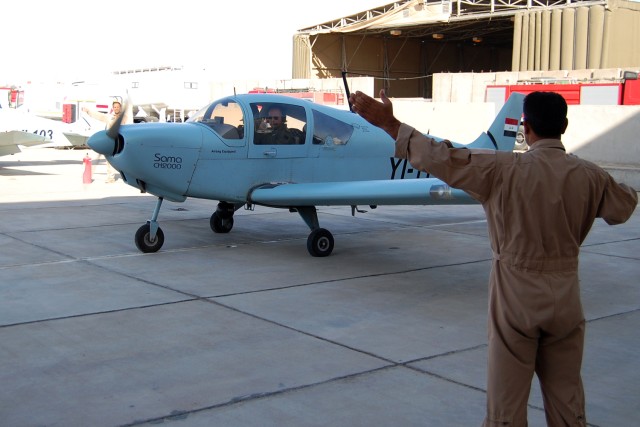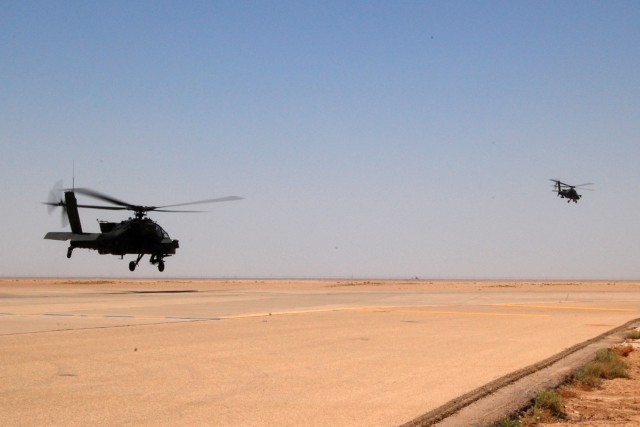CONTINGENCY OPERATING BASE BASRA, Iraq -- The air was clear over Contingency Operating Base Basra June 27, 2010, as the Iraqi commanders of the Basra Air Base and the 70th Squadron prepped their CH 2000 reconnaissance airplane for a first-ever joint mission with U.S. AH-64 Apaches.
The primary mission was air reconnaissance along the border with Iran, part of the regular responsibilities of the 70th Squadron, which is co-located with U.S. forces on COB Basra. As the first-ever joint mission of this type between Iraqi and U.S. forces, the flight also served as familiarization and proof-of-concept for future joint missions.
The two U.S. Apaches from Company C, 1st Attack Reconnaissance Battalion, 1st Aviation Regiment, based at Fort Riley, Kan., and operating out of COB Adder, Iraq, accompanied Col. Nazih al-Fahaed, 70th Squadron commander, and Brig. Gen. Sami Saeed, Basra Air Base commander, on the hour-long flight as back-up.
Both the Iraqis and U.S. Soldiers involved were pleased with the results of the patrol and expressed their hopes for similar success during future missions.
"We're looking for a good future," Fahaed said. "It was a great mission; it was good cooperation."
Working with the Apaches will be good practice for the Iraqi pilots in the future, Fahaed added.
The lower speed of the CH 2000s, which are propeller-driven, makes the Apaches a perfect match, he said.
Chief Warrant Officer Anthony Kinney, a Company C Apache pilot from Joplin, Mo., said that the aircraft and pilots had no issues functioning jointly.
"It was good working with them," he said. "We got the air-to-air coordination piece worked out. Flying with them was no problem."
The 70th Squadron provides support to ground forces, Fahaed said, and any immediately pertinent information discovered during missions is relayed back to the air base and to the Basra Operations Center, the headquarters for all Iraqi ground forces in Basra Province.
The 1-1 ARB pilots were there primarily to assist the Iraqi Air Force with this section of their responsibilities, Kinney said.
"We are trained, especially as Apache pilots, to integrate very closely with the ground forces," he said. "So we're just here to help them reintegrate back into the Iraqi Army so that they can take over their role as primary control of their own airspace."
This support to Iraqi ground forces goes back to operations in 2005 in Basra Province, Fahaed said.
"If we see something abnormal, like some vehicle crossing or some bad people crossing the border or smuggling, immediately we send a report," he said.
In addition, the Iraqi pilots have photographic and video equipment in the airplanes in order to document any activity on the ground, he said. The results are saved and distributed to both Iraqi and U.S. forces for analysis.
The Iraqi Air Force has come a long way since the purchase of its first CH 2000s in 2004, Saeed said.
"We started, from August 2004, with nine pilots and five maintenance. Now, in 2010, we are 300, with 40 pilots," Saeed said. "I think there is a big future for the pilots here."






Social Sharing